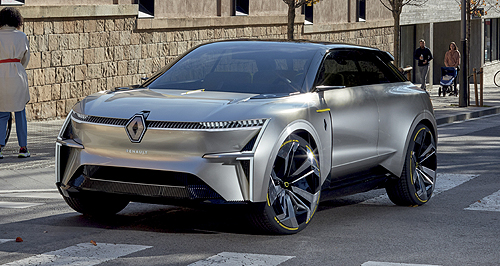Make / Model Search
News - RenaultRenault Morphoz concept to spawn family of EVsFamily tree: The Renault Morphoz will spawn a number of new EVs for the brand. Second generation of Renault EVs to score features seen in Morphoz SUV concept28 Apr 2020 RENAULT is planning a range of all-electric models previewed by the Morphoz concept SUV, which will usher in a new generation of electric vehicle for the French brand.
The range of EVs will sport a number of features seen on the Morphoz concept, although exactly which ones are yet to be detailed.
Renault concept designer Francois Leboine said the Morphoz would spawn multiple new EVs based on the Renault-Nissan-Mitsubishi alliance’s CMF-EV platform, with certain features from the wild Morphoz to be carried into production.
“This concept actually contains many things you will see on different cars coming of Renault, and actually one part of this concept was to announce not only a car which will come into production, but to announce a family of cars,” he said.
Mr Leboine said he was unable to discuss exactly what new features would make it into production, however one possibility includes offering unique wheelbase and powertrain combinations in the same car.
The Morphoz was shown in two configurations, the first of which was called the City, which measured 4400mm long with a 2700mm wheelbase and houses 40kWh batteries under the floor.
It is also offered with the Travel version, which extends vehicle length by 400mm, wheelbase by 200mm and the claimed range from 400km to 700km thanks to larger batteries, with the body extended below the A-pillar.
Renault also has plans for the Morphoz to use battery packs that can be swapped in and out of the car instantly for ease of use.
Mr Leboine suggested innovative technology should be shared across other companies and their own EVs, with Nissan and Mitsubishi obviously the most likely candidates for content sharing, however other bands outside the alliance could also be involved in tech sharing.
“What is interesting with this platform system is we can share this idea with other companies because if you think in terms of ecology you always have to open subjects to other companies – you have to think more global, you have to think less egoistically in a way,” he said.
“If it is interesting it has to be interesting for many companies, not just Renault.”
While not disclosing what type of vehicles will be built with the CME-EV platform, Mr Leboine said it would fit a range of applications, however there were certain body styles that would be best suited to the platform.
While the general consensus among designers is that an all-electric platform allows for greater freedom when working on a cleansheet design, Mr Leboine said the CME-EV platform is still limited by a number of factors that may rule out wild and futuristic body styles.
“In terms of height and proportion compared to what a designer could imagine … we already think that making an electric car is giving pure freedom to designers,” he said.
“I want to warn you that it’s not true yet, not on this generation. The second generation of electric car is not giving full freedom to designers just because the weight and quantity of batteries and the way that they are laid out in the car.
“So I just said that at the moment, in terms of pure strategy, we have to adapt what is the best design for the type of platform we have, to please people in the future.”
With those factors in mind, the most logical body shape for a production Renault EV would be an SUV like the Morphoz, which would also make sense given the ever-increasing popularity of SUVs across the globe.
The platform itself leads to an SUV as well, given that the underfloor batteries tend to give the body tall proportions, while also adding weight similar to that expected of an SUV.
Mr Leboine said the second generation of Renault EVs would mark the death of funky, off-beat offerings like the Twizy, that would not be able to succeed in today’s market.
Mr Leboine explained that the first generation of Renault EVs had limited competition in the market, which allowed the brand to shape the direction of the vehicle and to be more free and expressive in its design.
However in the current day, the range of competitors is constantly growing, which forces Renault to create a car that will appeal to a broader audience of buyers and must stack up against its rivals with excellent features and quality.
Mr Leboine also extolled the virtues of increased interior space that will be made possible by EVs, to the point where we may have to see the reclassification of car segments, as B-segment EVs will have the interior space of a C-segment vehicle, a C-segment car will have the space of a D-segment car, and so on.
When asked whether the alliance partners shared designs for their vehicles, he said that the platform design was shared, but aesthetic design and features were separated across brands.
No timeline has yet been given for the arrival of Renault’s next generation of EVs underpinned by the CME-EV platform.
Mr Leboine has worked on a number of concept vehicles for Renault, including the EZ family of concepts consisting of the EZ-Go, EZ-Pro and EZ-Ultimo.  Read more |
Click to shareRenault articlesResearch Renault Motor industry news |











Facebook Twitter Instagram